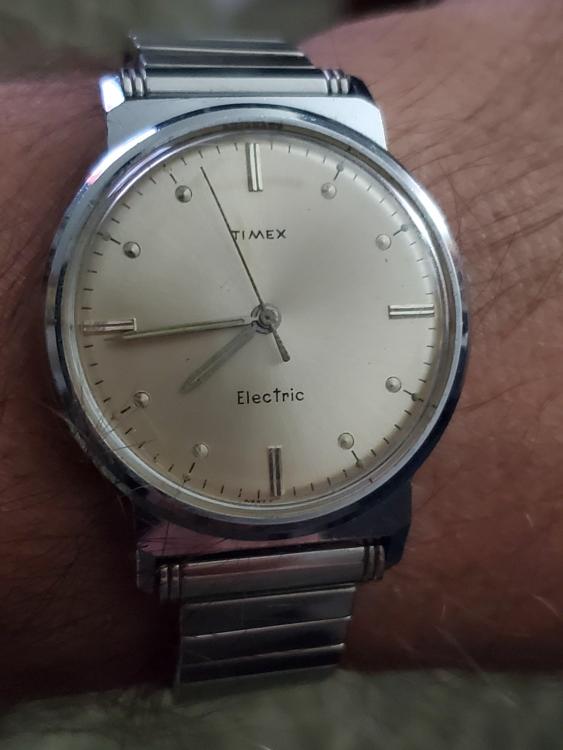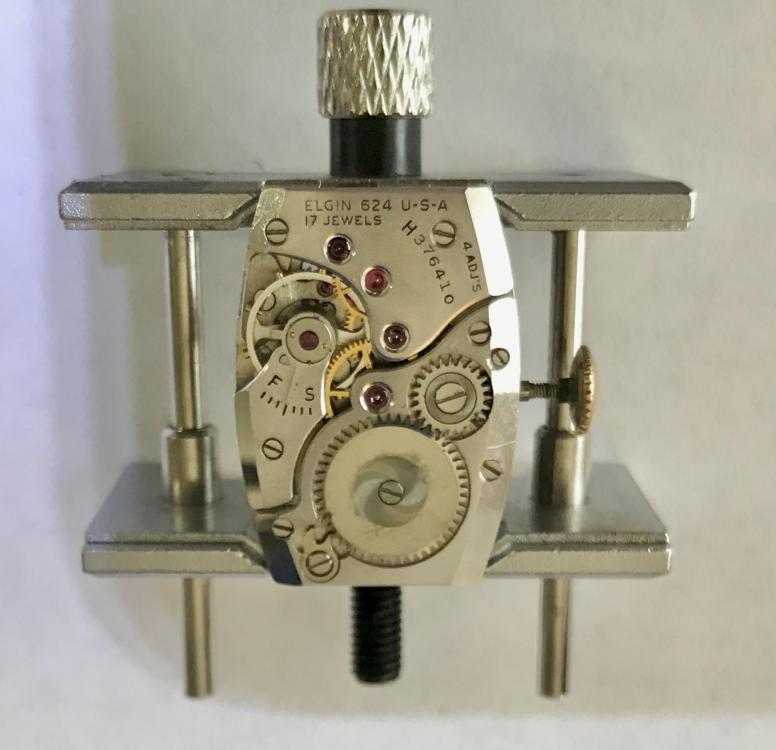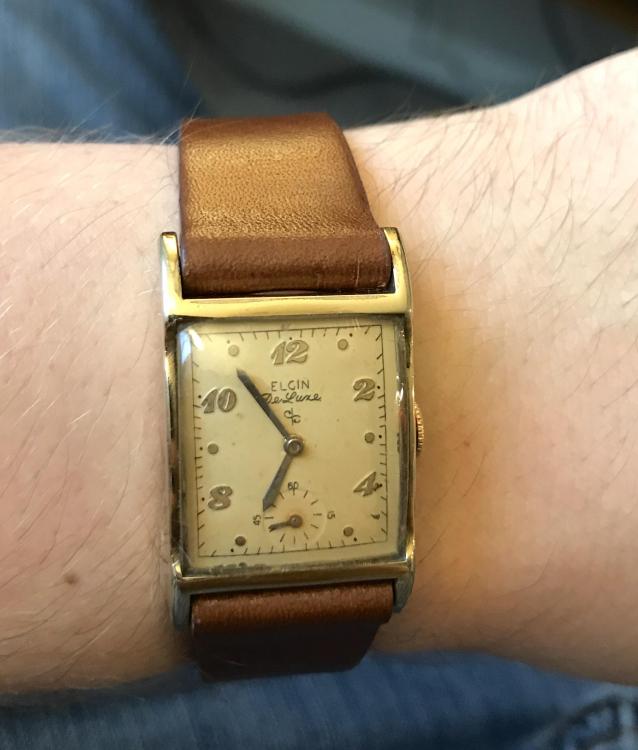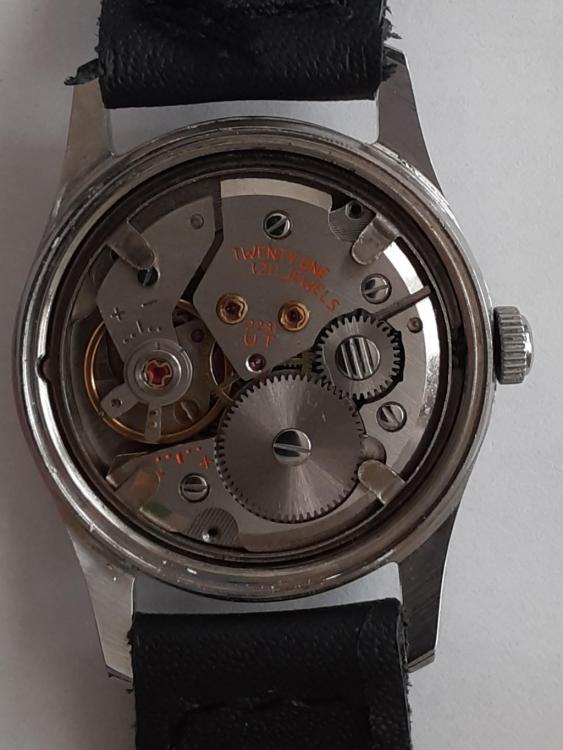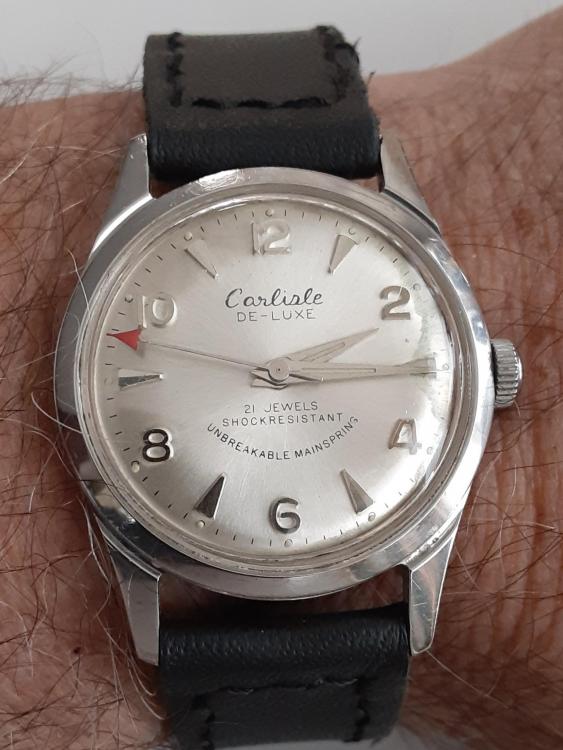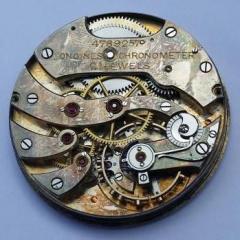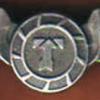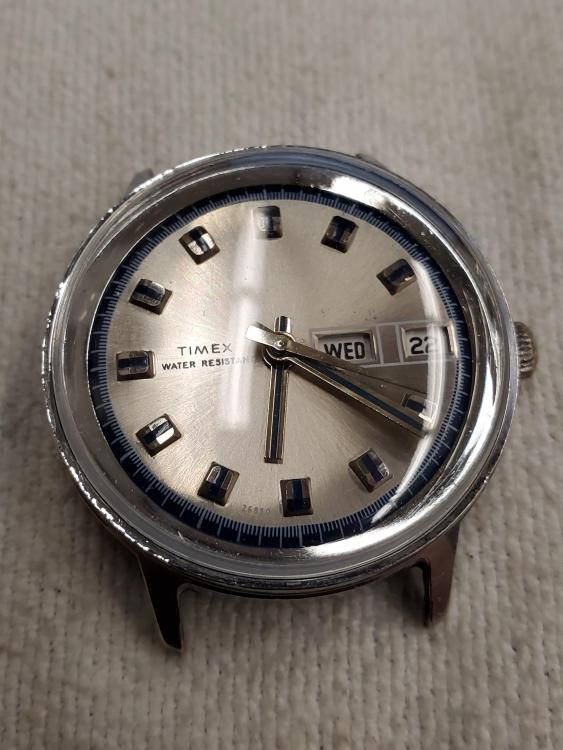Leaderboard
Popular Content
Showing content with the highest reputation on 01/29/20 in all areas
-
Hi You will probably find the attached tech sheet handy in re assembling the watch Good luck cheers 11 AOAC, D, B.pdf4 points
-
So, today im putting some mileage on my newly acquired 1963, West German manufactured, Timex backset electric. I purchased it as a parts donor for another watch, but it was working when I opened the package from the mail and, well it looks great for a nearly 60 year old watch. So, here it is. Jerseymo says the chrome case models are getting rare. Happy to revive some history.4 points
-
The 10BPAC sits in the same family as the 11ACAC and there are some good pictures here: https://watchguy.co.uk/repair-service-bulova-10bpac/2 points
-
Quarter screw and meantime screw means the same thing, I think the Brits say "quarter" more where Yanks say meantime. Some watches have 4, at 90 degree spacing (thus "quarter screw"), some just 2. When there are just 2 they are typically at the arms like in your watch. They are just for getting the balance close to a general (mean) time, with the regulator in the middle of its course. It's very much discouraged to use them for correcting poise error, although you can if it's just a small adjustment. So you have two meantime or quarter screws, the rest are just balance screws. The meantime screws will always have a longer thread, and show some resistance to turning even when not screwed down- they will in fact generally not be screwed right down to the rim. The regular balance screws will always be a free fit on the thread, and always need to be screwed down tight. Timing washers are used on these screws if needed. Balance screw holders are very nice to have, really essential for small balance screws, when dealing with adding washers. They are essentially little pinvices with sized tips, Bergeon sells them.2 points
-
Hi For the timegrapher to automaticaly record the watch beat it needs a constant frequency from the watch to lock on to the be able to calculate the BPH using its on board crystal oscillator (caliblated) whats happening is it cannot find that frequency or its not stable enough, Due to as NIcklesilver has mentioned to several possibilities he has outlined. difficult to remotely diagnose. First check the timegrapher on another watch to make sure its working ok, then its down to the watch.2 points
-
2 points
-
Did you clean it assembled? When you say mainspring, do you mean hairspring? That could be it. Or 13 different other things... Did you oil the pallet stones? (you should, lightly) Did you oil the pallet pivots? (shouldn't, but that wouldn't cause your reading) It just takes a piece of dust to cause what you're seeing, or any number of mechanical faults. Next to impossible to say from here.2 points
-
The thin spindle thing is the seconds hand - that goes into the middle of the movement. On top of it the metal long finger looking thing goes in to hold it down - it screws into the movement either near the balance cock or somewhere on the side with the 3rd and 4th wheels. The spare gear that you have goes on top of one of the gears in the drive train, before or after the winding mechanism is assembled from what I can see.2 points
-
2 points
-
2 points
-
So the timing washers would be placed on the two opposing screws that are 90 deg from the balance arms. Is this correct? By the way, thanks for the advice. And is there a book that explains the placement of timing screws . I do have the tools needed to work with the balance screws:) Sent from my iPhone using Tapatalk Pro1 point
-
Unscrew the hairspring stud screw while the balance is still installed (will make things easier) and remove the balance afterwards. Don't unscrew it too much so that it falls out of the slot. Then you just remove the hairspring and balance like any watch, yes.1 point
-
You're not going to have much luck with this. Besides, those crystals might very well fit other watches/models as well. Most people don't put up watches for sale with all the numbers that they find on them in the title so therefore it's not going to be easy. You could look up individual watch models and then try to find them online. (still not easy) Maybe if you can find images of them in old catalogues or printed ads.1 point
-
Hi The 11ACAC is from 1956 and so far specific data has been hard to find as has been the 10BPAC. Plenty of tech sheets on the newer ones.1 point
-
@brenguywow thats awkward i have never seen that. have you tried it in other positions? I just see it in the DU position in the video and in that position you cant see how the balance or escape is functioning. One trick i learned from DeCarle is you can take the movement and press it against your ear. start with your head at a 90 degree angle parallel to the floor (so its movement is in DU), then while holding the movement next to your head, move your head from side to up to other side then back then forward to mimic some of the positions you would use on the timegrapher, while slowly moving your head in all of these positions listen for any inconsistencies in the beat or ticking. This how they did it before timegraphers came out. And it is one of the best ways to detect a positional beat error when technology fails you.1 point
-
I sure hope you didn't use this stuff for your oiling!? As @nickelsilver stated; it's basically impossible to tell what's causing the timegrapher readings, and like @watchweasol suggests, make sure the timegrapher is working properly with another watch first. Depending the gravity of the mainspring kink, I guess it could cause some real problems, but I've kinked the inner coil of a few mainsprings a bit while adjusting them (Generale Ressorts) to fit the arbor and haven't had any real problems so far Servicing and repairing a watch is a delicate process, think brain surgery (without the risk of a patient dying) , and many things can go wrong. You mention the use of oiling the movement and I would assume some Bergeon oil (not Burgeon hair oil). However, use the wrong type of oil or the wrong amount of oil (which you more than likely have and we've all been there) it could have a very negative impact on the running of the watch. I'm in no way affiliated with @Markwho's running this site, but I would definitely recommend www.watchrepairlessons.com. Worth every single penny if you ask me! Good luck and keeps us updated, We sure wish to help you if we can!1 point
-
That sounds familiar, I just bought a job lot of "small seconds" hands, because I needed one, and a tube of about 100 random ones came up for lest than the cost of buying just one. I will try to resist the temptation to buy 100 more watches to use up the rest of the hands.1 point
-
I would say both movements are as you know are tried and tested Sellitia being an builder and supplier of ETA movements in the past, so on that score its down to personal choice in the watch case and design which is entirely yours.1 point
-
How good are your fine motor skills? Watch those two videos, and you will get a good feel for what is involved. The secret is to make tiny adjustments, and take your time. Patience and care. When you start going cross eyed, and feel like throwing in the towel, take a break and come back to it later when you are fresh. @JerseyMo may have these balances available as spares, but learning to fix them is a worth while watch repair skill to develop.1 point
-
1 point
-
If the pivots are OK and the end-shake too much I would also check that the balance cock is not bent upwards. If that is fine I would consider driving the mainplate balance jewel setting deeper a bit. You will have to check that the impulse jewel is still within the horns. Yes it is a bodge but whose to say it wasn't driven deeper earlier? ie when replacing a shock spring etc. Anilv1 point
-
nope, taking it out is the only way I know. Well it maybe magnetized.....too.1 point
-
1 point
-
I have had one interesting problem with a landeron 148 . The chronograph hand was either to long or to thick in the tube. If i pressed it on to tight the chronograph stopped . I changed to an other hand and it worked fine. Don't now if this help . As i don't know if you have the hands on .1 point
-
Hard to see from the photos, but would that be 14 good ticks then a step? Check the escape wheel for a damaged or dirty tooth.1 point
-
I have found a .more than fair amount of case back swapability with seiko. From what I can tell the shape of the back is dependent on the type of rotor. Unless that case back is an absolutely must have,one from a watch with the same movement may work until a match can be found.1 point
-
i personally think ebay is the best source, speedtimerkollection doesnt always have the harder to find case backs like the ones you mentioned and I highly doubt they will have a bullhead case back.1 point
-
Post a WTB on SCWF and Wristsushi . Have some 6139 case backs. But no 7100 . 6138 cases i have seen on Ebay . Or buy a donor watch .1 point
-
Hi Try osoleteclockandwatchparts.co.uk I have picked up a few seiko bits from him. Its run by John senior in Yorkshire.1 point
-
https://speedtimerkollektion.com/ is a good source of parts for Seiko you will just have to keep looking, both the watches you need backs for are very collectable now and demand high prices so I doubt any one would sell any case parts for them cheap.1 point
-
My understanding is that the clicks or whatever they're called in the reversers have to be absolutely free to move and lubrication would Interfere with that. So epilame treatment is applied to keep lubrication away. Notice they're using HP 1000 on the center part and there would be a likelihood without surface treatment of that spreading out. Then you're absolutely correct in the video Mark applies a drop of lubrication on the reverser wheels which by theory would spread to the little clicks and interfere with how they work. But this is lubrication in horology everyone has a different idea if it works for Mark and long term it works for Mark then?1 point
-
1 point
-
Like Marc I get puzzled by some peoples dismissive attitude to Timex. They are not high precision jewelled watches and they don't need servicing like they are - procedures as outlined in the manuals are fine most of the time. Nearly every Timex I've had (and that is a lot) in a non working condition has been quickly returned to life. For those that aren't I have boxes of spares, and official Timex repair kits as supplied to watchmakers - or those that used them anyway. Providing you know what you are doing it is not that difficult to take apart and put together the movements either, it's just obviously not as easy dealing with two plates rather than bridges - all those pivots need lining up at once . Again there seems to be a common belief that you can't do this as the movements are riveted. In my experience only a minority of very early movements are like this, the vast majority use screws. I suppose I shouldn't complain though as people dismissing them out of hand means they are still very cheap to buy. I like the virtually endless different dial designs you can get, and some of the cases are pretty good as well. Each to their own. Stephen1 point
-
it's certainly true to say that there are a lot of watchmakers out there who consider Timex's own published service procedures to be inadequate, and the design philosophy and build quality of their watches to be contemptibly inferior. This is something that I have never understood; it's almost as though there is amongst watchmakers a culture of bias against the brand, dare I say it, an element of snobbery. It's also quite correct that Timex's service procedures would be wholly inappropriate for a fully jewelled movement, in much the same way that the service requirements for a Ferrari differ from those of Ford, but if your garage tried to tell you that they need to service your Ford in accordance with the Ferrari service procedures (and that they should charge you accordingly), because the published Ford procedures are inadequate you would quite rightly question their rationale and take your custom else where. I can only speak from my own experience and that includes quite a lot of Timex watches. There are definitely some aspects of Timex design that I dislike, just as there are design aspects of many other Swiss, American, Russian, and English watches that irritate me, however, I don't think that their durability can be questioned. What is more, from experience I can happily say that the vast majority of apparently dead, 50 years old and never been serviced and look like they've spent most of their life in a war zone Timex's that I have then given the Timex spa treatment, have straight away sprung back into life and gone on to perform as designed. If that isn't evidence of an effective service procedure then I'm not sure what is. And as I said before, I have never encountered a broken Timex balance staff. Obviously other people have different experiences and accordingly (and quite rightly) will have arrived at their own opinions. What I find so difficult to accept, let alone understand, is the (so often repeated) assertion Timex watches were never intended to be repaired or serviced. The fact that Timex went to the trouble and expense of publishing service manuals and tech sheets, and providing a supply of spare parts is proof positive that they were meant to be serviced. And my own experience with them has demonstrated to me that the published service procedures are not only perfectly effective, but also incredibly simple to carry out.1 point
-
I have read the servicing procedures recommended by Timex. However I personally do not believe a watch can be effectively serviced without it being stripped inspected and cleaned. Many watchmakers also agree and thats why they do not entertain a Timex.1 point
-
OH is quite correct in that you need to remove the dial in order to access the click and safely let down the main spring. CB has also provided the service manual which if followed will result in an effectively serviced Timex. Contrary to popular opinion Timex watches were manufactured with servicing in mind and Timex had in place the supply of all spare parts for exactly this purpose. The servicing procedures that Timex outline in the servicing manual were specifically developed to facilitate a simpler and cheaper approach to servicing a movement which was itself designed with this approach to servicing in mind. I get the feeling that a lot of he more traditional watchmakers got frustrated with Timex movements because rather than adopting the Timex procedures they tried to fully disassemble the watch to clean it and subsequently struggled to reassemble it, resulting in a hatred and disrespect for the brand. Looked after the way that Timex intended, they are perfectly capable time keepers (not Rolex precision granted, but perfectly adequate) and significantly more robust than the fully jewelled, 10x the price, Swiss alternatives. I've never come across a "V-Conic" balance with a broken pivot for instance.1 point
-
I have not found a effective way to service a Timex. Timex watches were produced to be used and then replaced. This might help but how to actually remove the plate is not explained but on page 24.4 shows how to let the mainspring down. Timex 24.pdf1 point
-
Timex mechanical watches were not really designed to be serviced, the service usually costing more than the watch cost. They are not made the same as a Swiss watch and cannot easily be dismantled, being of low value there is little point in spending a lot of time trying to get one running properly, unless it is of mentisental value. I believe the correct way to clean one is to remove the hands and dial and put the whole movement in cleaning fluid, dry it off when clean and then re-oil the moving bits and pieces. :thumbsu:1 point
-
Im am currently shopping for my new watch. I have narrowed it down to two. The first is the Sinn 104 st sa b on a fine link bracelet. The other is an Edox 01114 3M BUIN Chronoffshore. The Sinn sports a Sellita 220-1 and the Edox carries the well tested workhorse ETA Valjoux 7750. This is where asking for opinions comes in. I was wondering if anyone had any thoughts on which movement is more reliable. From what I've read on the web there isn't much difference, as Sellita is very practiced at recreating ETA's movements. It seems that its kind of a heated debate so I hope I didn't just start a war lol. Thanks in advance.0 points
-
Marc your right there we sent them back to Dundee to Timex (I think that was the place) we also used to take our frustration out on them and smash them up with a hammer. I can sum up Timex in one word RUBBISH0 points



